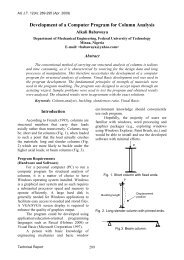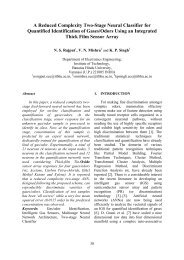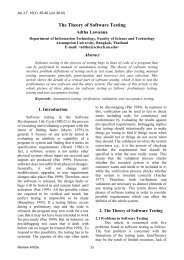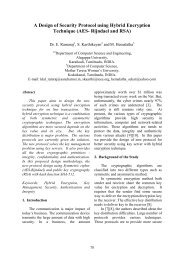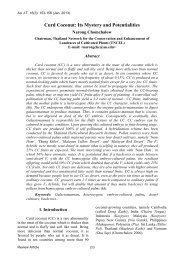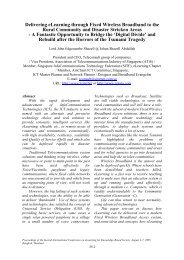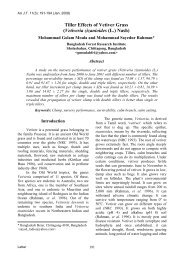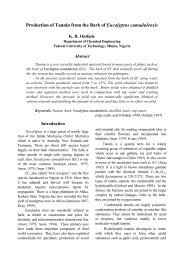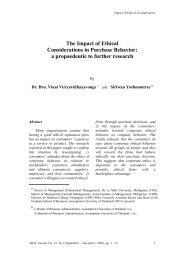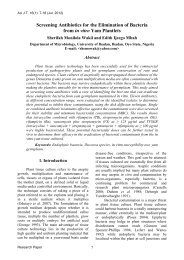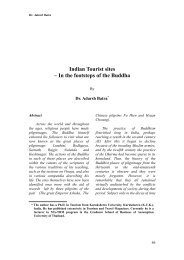AU Abstracts 2009 - AU Journal - Assumption University of Thailand
AU Abstracts 2009 - AU Journal - Assumption University of Thailand
AU Abstracts 2009 - AU Journal - Assumption University of Thailand
Create successful ePaper yourself
Turn your PDF publications into a flip-book with our unique Google optimized e-Paper software.
<strong>Abstracts</strong> <strong>of</strong> Scientific Papers<br />
Presented by the Staff <strong>of</strong><br />
<strong>Assumption</strong> <strong>University</strong><br />
at<br />
International Scientific Meetings<br />
From July 2008 to June <strong>2009</strong><br />
Prepared and published by<br />
Office <strong>of</strong> the <strong>AU</strong> <strong>Journal</strong> <strong>of</strong> Technology<br />
<strong>Assumption</strong> <strong>University</strong><br />
Bangkok, <strong>Thailand</strong><br />
July <strong>2009</strong>
About this publication:<br />
Title: <strong>AU</strong> ABSTRACTS – <strong>2009</strong><br />
Extended Title: <strong>Abstracts</strong> <strong>of</strong> Scientific Papers Presented by the Staff <strong>of</strong> <strong>Assumption</strong><br />
<strong>University</strong> at International Scientific Meetings from July 2008 to June <strong>2009</strong><br />
Prepared by: Narong Chomchalow, Editor, <strong>AU</strong> <strong>Journal</strong> <strong>of</strong> Technology, Office <strong>of</strong> the<br />
President, <strong>Assumption</strong> <strong>University</strong><br />
Editor: Narong Chomchalow, Ph.D.<br />
Deputy Editor: Dobri Atanassov Batovski, Ph.D.<br />
Publisher: <strong>Assumption</strong> <strong>University</strong>, Bangkok, <strong>Thailand</strong><br />
Date Published: July <strong>2009</strong><br />
For copies write to:<br />
The <strong>University</strong> Information Center<br />
<strong>Assumption</strong> <strong>University</strong><br />
Ram Khamhaeng Road, Soi 24<br />
Hua Mak, Bangkok 10240, <strong>Thailand</strong><br />
Tel. +66 (0) 2300-4543 to 53<br />
Fax +66 (0) 2300-4511, 2300-4563<br />
ii
Preface<br />
Being an institute <strong>of</strong> higher learning, and the first international university in<br />
<strong>Thailand</strong>, <strong>Assumption</strong> <strong>University</strong> has a definite policy to provide quality instruction to the<br />
students, both undergraduates and graduates, and both Thai and foreign nationals. An<br />
equally important function <strong>of</strong> the <strong>University</strong> is to conduct research in all fields.<br />
<strong>Assumption</strong> <strong>University</strong> is one <strong>of</strong> the leading universities in the field <strong>of</strong> science and<br />
technology. During the past year, several <strong>of</strong> our faculty members participated in various<br />
international meetings held in <strong>Thailand</strong> and abroad; many have also presented their<br />
papers at these meetings. The Management <strong>of</strong> <strong>Assumption</strong> <strong>University</strong> is proud <strong>of</strong> their<br />
performance and achievements.<br />
To display and maintain a record <strong>of</strong> their endeavors and achievements, and to<br />
encourage other faculty members to make similar contributions, all abstracts <strong>of</strong> scientific<br />
papers presented at the international scientific meetings during this one-year period<br />
from July 2008 to June <strong>2009</strong>, have been compiled and published for distribution to<br />
interested individuals and institutions. The present publication is the eleventh issue <strong>of</strong><br />
the series <strong>of</strong> the <strong>AU</strong> <strong>Abstracts</strong>, published annually. The first one, ‘<strong>AU</strong> <strong>Abstracts</strong> - 1999’<br />
was published in September 1999, covering the presentation period from May 1998 to<br />
June 1999. Subsequent publications <strong>of</strong> the series were published in July covering a<br />
period from July <strong>of</strong> the previous year to June <strong>of</strong> the next year.<br />
Originally, the Office <strong>of</strong> the <strong>AU</strong> <strong>Journal</strong> <strong>of</strong> Technology who initiated this publication,<br />
was charged with the responsibility to cover the activities <strong>of</strong> five ‘technology based’<br />
faculties and schools, namely: School <strong>of</strong> Architecture, Faculty <strong>of</strong> Biotechnology, Faculty<br />
<strong>of</strong> Engineering, Faculty <strong>of</strong> Nursing Science, and Faculty <strong>of</strong> Science and Technology. As<br />
a few other faculties and schools also presented a number <strong>of</strong> ‘technological’ papers,<br />
they too are included in this publication.<br />
It is hoped that this small publication would be <strong>of</strong> some benefit to our readers and<br />
that it will serve a dual purpose, relaying information, as well as an encouragement to all<br />
the faculty members <strong>of</strong> the ‘technology based’ faculties and schools. It is our desire to<br />
continue to present this particular series and publication every year.<br />
On behalf <strong>of</strong> <strong>Assumption</strong> <strong>University</strong>, I wish to express my sincere thanks to Dr.<br />
Narong Chomchalow, Editor <strong>of</strong> the <strong>AU</strong> <strong>Journal</strong> <strong>of</strong> Technology, for his initiative, as well<br />
as hard work in compiling, overseeing, and preparing the manuscripts <strong>of</strong> the <strong>AU</strong><br />
<strong>Abstracts</strong> - <strong>2009</strong>. I also wish to thank Dr. Dobri Atanassov Batovski, Deputy Editor <strong>of</strong><br />
the <strong>AU</strong> <strong>Journal</strong> <strong>of</strong> Technology, who assisted in editing the abstracts <strong>of</strong> this publication.<br />
Dr. Bancha Saenghiran, FSG<br />
President, <strong>Assumption</strong> <strong>University</strong><br />
iii
Contents<br />
Preface …………………………………………………………………………………(iii)<br />
Biotechnology, Faculty <strong>of</strong> .……………………………………………………………...1<br />
Engineering, Faculty <strong>of</strong>………………………………………………………………… 5<br />
Information Technology, Graduate School <strong>of</strong> ………………………………………. 9<br />
President, Office <strong>of</strong> the .………………………………………………………………13<br />
Science and Technology, Faculty <strong>of</strong> ………………………………………………..17<br />
See detailed contents on the back page <strong>of</strong> each faculty/school identity sheet)<br />
iv
Faculty <strong>of</strong><br />
Biotechnology<br />
1
Faculty <strong>of</strong> Biotechnology<br />
The 22 nd Biennial Conference <strong>of</strong> the Asian Association for Biology Education<br />
(AABE22)<br />
Osaka, Japan, 22-24 November, 2008<br />
1. The Study <strong>of</strong> Biosurfactant as a Cleaning Agent for Insecticide Residue in Leafy<br />
Vegetable<br />
Churdchai Cheowtirakul ……………………………………………………………………3<br />
2
The Study <strong>of</strong> Biosurfactant as a Cleaning Agent for<br />
Insecticide Residue in Leafy Vegetable<br />
Churdchai Cheowtirakul and Nguyen Dieu Linh*<br />
Faculty <strong>of</strong> Biotechnology, <strong>Assumption</strong> <strong>University</strong><br />
Pesticides are used as the main tool for agricultural pest control. Many pesticides<br />
are, however, toxic substances and persistent in character. Concern over the pesticide<br />
residues in fruits and vegetables has led to the development <strong>of</strong> many clean up and<br />
analysis methods.<br />
Biosurfactant was used in this study to explore the possible potential for cleaning<br />
up cypermethrin residue. Lettuce was chose as a representative for leafy vegetable.<br />
Amounts <strong>of</strong> biosurfactant and the contact times needed to reduce cypermethrin residue<br />
in lettuce to below maximum residue limit <strong>of</strong> 2 ppm to make it safe for consumers were<br />
determined. Salt, vinegar and potassium permanganate were also tested for comparing<br />
the cypermethrin neutralizing effect on lettuce with biosurfactant. A simple method to<br />
determine cypermethrin residue was developed, based on ninhydrin test which is the<br />
reaction <strong>of</strong> ninhydrin reagent with free nitrogen to form a color product which can be<br />
detected by spectrophotometer.<br />
With the initial pesticide concentration <strong>of</strong> 100 ppm the amount <strong>of</strong> biosurfactant that<br />
needs to be used was 10 ppm <strong>of</strong> biosurfactant for 25 min, 15 ppm <strong>of</strong> biosurfactant for<br />
15 min and 20 ppm <strong>of</strong> biosurfactant for 5 min. With the initial pesticide concentration <strong>of</strong><br />
10 ppm the amount <strong>of</strong> biosurfactant that needs to be used was 2 ppm for 3 min, 3 ppm<br />
for 3 min, and 4 ppm for 1 min. Adding KMnO 4 together with biosurfactant caused the<br />
synergistic effect that would further enhance the efficiency <strong>of</strong> this cleaning method.<br />
From this study it was concluded that biosurfactant could be used as an effective agent<br />
to clean up pesticide similar to the group <strong>of</strong> cypermethrin on leafy vegetables.<br />
Keywords: Pesticide residues, toxic substances, cypermethrin, lettuce, ninhydrin<br />
test, synergistic effect.<br />
Presented at: The 22nd Biennial Conference <strong>of</strong> the Asian Association for Biology<br />
Education (AABE22), Osaka, Japan. 22-24 November 2008.<br />
Published in: Proc <strong>of</strong> AABE22, p. 5.<br />
Full paper requisition: <br />
* A candidate from Ho Chi Minh City, Vietnam, applying for a Fulbright scholarship.<br />
3
Faculty <strong>of</strong><br />
Engineering<br />
5
Faculty <strong>of</strong> Engineering<br />
21 st Inter-<strong>University</strong> Conference <strong>of</strong> the Association <strong>of</strong> Southeast Asian<br />
Institutions <strong>of</strong> Higher Learning – <strong>Thailand</strong> (ASAIHL – <strong>Thailand</strong>), Theme: <strong>University</strong><br />
Autonomy<br />
Meeting Room Phraya Sri Wisarnwaja, Office <strong>of</strong> the <strong>University</strong>, Chiang Mai<br />
<strong>University</strong>, Chiang Mai, <strong>Thailand</strong>, 17 October 2008<br />
1. Some Distinctive Features <strong>of</strong> Engineering Education in Russia Compared to <strong>Thailand</strong><br />
and Other Countries<br />
Gennady Veselovsky ……………………………………………………………………….7<br />
The International Association <strong>of</strong> Science and Technology for Development<br />
(IASTED) International Conference on Parallel and Distributed Computing and<br />
Networks (PDCN <strong>2009</strong>)<br />
Innsbruck, Austria, 17–18 February <strong>2009</strong><br />
2. Permuting Ability <strong>of</strong> Uniaxial 2D and 3D Tori under Dimension-Order Routing<br />
Gennady Veselovsky ……………………………………………………………………….8<br />
6
Some Distinctive Features <strong>of</strong> Engineering Education in<br />
Russia Compared to <strong>Thailand</strong> and Other Countries<br />
Gennady Veselovsky<br />
Faculty <strong>of</strong> Engineering, <strong>Assumption</strong> <strong>University</strong><br />
This paper considers some distinctive characteristics <strong>of</strong> the Russian system <strong>of</strong><br />
higher education in engineering. Examples <strong>of</strong> such outstanding contributions include<br />
aircraft engineering, space technology and high performance computing. These<br />
achievements are the result <strong>of</strong> the Russian efficiency in training engineers. One salient<br />
aspect <strong>of</strong> the Russian system is its strong emphasis on fundamental subjects – e.g.<br />
mathematics and physics – and the compulsory apprenticeship in the best companies<br />
beginning in the third year <strong>of</strong> studies. The Russian system is unique compared to other<br />
universities. All exams are oral, there are no mid-term exams, only final ones. The<br />
curriculum is fixed and must be followed in strict sequence. At present, Russia is in the<br />
process <strong>of</strong> reforming its higher education system. This reform involves the transition<br />
from one-level certifying system involving a diploma, to a two-level certifying system<br />
involving a Bachelor’s and Master’s degrees. This is to allow its programs to be<br />
recognized globally. It also involves the establishment <strong>of</strong> a “federal system” which would<br />
include the most prestigious universities. These “federal universities” are entitled to<br />
larger funding from the state budget and greater autonomy than other universities. This<br />
paper conducts a comparative analysis for the Electrical Engineering (EE) and<br />
Computer Engineering (CE) <strong>of</strong>fered at various institutes in different countries (including<br />
<strong>Assumption</strong> <strong>University</strong> <strong>of</strong> <strong>Thailand</strong> and Asian <strong>University</strong>). It has been found that,<br />
compared to other universities, what is distinctive about <strong>Assumption</strong> <strong>University</strong> is its<br />
relatively low number <strong>of</strong> fundamental courses and a high number <strong>of</strong> pr<strong>of</strong>essional<br />
courses. This study employs the k-parameter method recommended by UNESCO.<br />
Keywords: Engineering education, Russian system, effectiveness, emphasis on<br />
the fundamentals, k-parameter method.<br />
Presented at: 21 st Inter-<strong>University</strong> Conference <strong>of</strong> the Association <strong>of</strong> Southeast<br />
Asian Institutions <strong>of</strong> Higher Learning – <strong>Thailand</strong> (ASAIHL – <strong>Thailand</strong>), Theme:<br />
<strong>University</strong> Autonomy, Meeting Room Phraya Sri Wisarnwaja, Office <strong>of</strong> the <strong>University</strong>,<br />
Chiang Mai <strong>University</strong>, Chiang Mai, <strong>Thailand</strong>, 17 October 2008.<br />
Published in: Proc. 21 st ASAIHL – <strong>Thailand</strong> Inter-<strong>University</strong> Conference and <strong>AU</strong><br />
J.T. 12(2): 92-07 (Oct. 2008).<br />
Full paper requisition: <br />
7
Permuting Ability <strong>of</strong> Uniaxial 2D and 3D Tori under<br />
Dimension-Order Routing<br />
Gennady Veselovsky<br />
Faculty <strong>of</strong> Engineering, <strong>Assumption</strong> <strong>University</strong><br />
Permutations belong to communications patterns demanded frequently in<br />
massively-parallel computers especially <strong>of</strong> the SIMD type. A permutation is said<br />
“admissible” to a given interconnection network if it does not cause blockings in that<br />
network under a chosen routing algorithm. Determining the admissibility <strong>of</strong> a given<br />
permutation to various static connecting topologies is a fundamental problem. Based on<br />
congruence notion from number theory, this paper presents a simple method which<br />
solves admissibility problem for regular permutations to uniaxial 2D and 3D tori under<br />
deterministic dimension-order routing commonly used in practice. Here “uniaxial” means<br />
that in every routing step all data items participating in a permutation can move along<br />
the same axis only. It is assumed that all nodes <strong>of</strong> a system work in a synchronous<br />
fashion what is also characteristic to SIMDs. The efficiency <strong>of</strong> the method is illustrated<br />
by the examples with determining admissibility <strong>of</strong> some frequently used in parallel<br />
programming permutations which belong either to Omega or BPC (bit-permutecomplement)<br />
classes.<br />
Keywords: Interconnection network, torus, dimension-order routing, permutation<br />
admissibility.<br />
Presented at: The International Association <strong>of</strong> Science and Technology for<br />
Development (IASTED) International Conference on Parallel and Distributed Computing<br />
and Networks (PDCN <strong>2009</strong>), Innsbruck, Austria, 17-18 February <strong>2009</strong>.<br />
Published in: Proc. PDCN <strong>2009</strong>.<br />
Full paper requisition: <br />
8
Graduate School <strong>of</strong><br />
Information Technology<br />
9
Graduate School <strong>of</strong> Information Technology<br />
International E-learning Conference 2008, Impact Arena, Mueang Thani, Pathum<br />
Thani, <strong>Thailand</strong> , 20-21 November 2008.<br />
1. Providing the eLearning Services for the Blog<br />
Ridwan Sanjaya and Saranphong Pramsane ………………………………………….11<br />
10
Providing the eLearning Services for the Blog<br />
Ridwan Sanjaya* and Saranphong Pramsane<br />
Graduate School <strong>of</strong> Information Technology, <strong>Assumption</strong> <strong>University</strong><br />
Nowadays, Weblog or Blog is common to the people in the world, including those<br />
who work in the education field. People use it because <strong>of</strong> the easiness. Some lecturers<br />
use it to share their class meeting material to their students. Others use it to share their<br />
documents or presentations <strong>of</strong> research and workshop. They also can upload the<br />
multimedia contents to the Blog to describe the knowledge in more detail. However, the<br />
Blog features are not the same with the Learning Management System (LMS) features.<br />
The LMS s<strong>of</strong>tware usually provides the facility to do the eLearning activities, such as<br />
giving a quiz to the students, sending the assignments to the lecturers, and grading the<br />
assignments. Blog does not provide those eLearning features. It needs additional<br />
elements/widget provider to provide the eLearning facilities. By combining the eLearning<br />
widgets from several providers to the Blog, people should get the benefits from the<br />
easiness <strong>of</strong> using the Blog and easiness <strong>of</strong> providing eLearning activities.<br />
Presently, there is no widget provider who is really supporting eLearning activities<br />
to their Blogs. Users have to combine several widgets from different providers to give all<br />
the eLearning services in their Blog. This paper explains the technical side to provide<br />
the eLearning supports for the Blog. The design <strong>of</strong> those supports should <strong>of</strong>fer the<br />
facility to upload a course material, creating a quiz or an assignment, sending the<br />
answer, and grading the assignments. However, it must not change the characters <strong>of</strong><br />
Blog which is easy to use by everyone.<br />
Keywords: Learning Management System, widget provider, weblog, grading,<br />
upload, easiness.<br />
Presented at: The 5 th International conference on eLearning for Knowledge-<br />
Based Society, Impact Arena, Mueang Thani, Pathum Thani, <strong>Thailand</strong>, 11-12<br />
December 2008.<br />
Published in: Proc. Int. E-Learning Conf. 2008, IJCIM 16(SP3).<br />
Full paper requisition::<br />
* Soegijapranata Catholic <strong>University</strong>, Semarang, Indonesia.<br />
11
Office <strong>of</strong> the<br />
President<br />
13
Office <strong>of</strong> the President<br />
The First Indian National Vetiver Workshop on, “Vetiver System for<br />
Environmental Protection and Natural Disaster Management”<br />
Hotel Sarovaram, Cochin, Kerala, India, 21-23 February 2008*<br />
1. Other Uses, and Utilization <strong>of</strong> Vetiver<br />
Narong Chomchalow ……………………………………………………………………..15<br />
2. The <strong>Thailand</strong> Vetiver Network<br />
Narong Chomchalow ……………………………………………………………………..16<br />
* Since both papers have not been included in <strong>AU</strong> <strong>Abstracts</strong> 2008, they are presented<br />
in this volume <strong>of</strong> the <strong>AU</strong> <strong>Abstracts</strong> even though the date <strong>of</strong> presentation is not the<br />
specified period <strong>of</strong> 1 July 2008 to 30 June <strong>2009</strong>.<br />
14
Other Uses, and Utilization <strong>of</strong> Vetiver<br />
Narong Chomchalow*<br />
Office <strong>of</strong> the <strong>AU</strong> <strong>Journal</strong> <strong>of</strong> Technology, <strong>Assumption</strong> <strong>University</strong><br />
In addition to being conventionally used to perform specific functions in soil and<br />
water conservation, environmental protection, disaster mitigation, slope stabilization,<br />
erosion control, absorption <strong>of</strong> heavy metals, wastewater treatment, etc., vetiver plant has<br />
also several other non-conventional uses, e.g. as forages, ornamentals (landscaping<br />
and decorative potted plants), dust and heat reduction, windbreak, insect trap, field /<br />
plot boundaries and wincing the car out from the ditch.<br />
Harvested (fresh, partly dried or dried) vetiver leaves, culms and roots are utilized,<br />
mostly after some degree <strong>of</strong> processing, in various ways such as: input <strong>of</strong> agriculturerelated<br />
activities including mulch, compost, nursery block / planting medium, fodder,<br />
mushroom cultivation, livestock bedding, rope to tie rice bundle, botanical pesticides<br />
and allelopathy; input <strong>of</strong> construction-related activities including ro<strong>of</strong> thatch, hut, mud<br />
bricks, prefabricated vetiver-clay blocks, vetiver-clay composite storage bin, particle<br />
board and panel, veneer and fiber board, straw bale, bale building, and cement<br />
replacement material (artificial pozzalans and ash for concrete work); handicrafts and<br />
art works including handy accessories, containers, decorative materials, home<br />
appliances, souvenirs and other objects; medicinal applications including traditional<br />
medicines and herbal drinks; perfumes and fragrances including perfumery,<br />
aromatherapy, flavor and potpourri; bouquets (fresh and dried); energy sources<br />
including ethanol and green fuel; industrial products including pulp/paper and panel;<br />
coolants including blinds or tatti, house mats, woven screens, hand fans, broom<br />
hangers, baskets, cabins, car ro<strong>of</strong>top mats; mattress and other stuffing.<br />
This paper also discusses: (i) the main objective <strong>of</strong> growing vetiver, (ii) the growing<br />
<strong>of</strong> vetiver as a cash crop for utilization, (iii) the ecological benefit <strong>of</strong> growing vetiver, and<br />
(iv) botanical pesticides from vetiver.<br />
Keywords: Forage, fodder, mulch, compost, mushroom cultivation, botanical<br />
pesticides, ornamentals, handicrafts, traditional medicines, perfumery, aromatherapy,<br />
pulp/paper, panel, energy sources, coolants.<br />
Presented at: The First Indian National Vetiver Workshop on, “Vetiver System for<br />
Environmental Protection and Natural Disaster Management”, Hotel Sarovaram,<br />
Cochin, Kerala, India, 21-23 February 2008.<br />
Published in:<br />
<br />
Full paper requisition: <br />
* Coordinator, Pacific Rim Vetiver Network; Chairman, Continuing Committee,<br />
International Conference on Vetiver.<br />
15
The <strong>Thailand</strong> Vetiver Network<br />
Narong Chomchalow*<br />
Office <strong>of</strong> the <strong>AU</strong> <strong>Journal</strong> <strong>of</strong> Technology, <strong>Assumption</strong> <strong>University</strong><br />
The vetiver activities in <strong>Thailand</strong> started from the work initiated by His Majesty<br />
King Bhumibol Adulyadej. From 1991, His Majesty conducted his own experiments and<br />
also advised the staff <strong>of</strong> the Royal Development Study Centers, the royal project’s<br />
stations, and various institutions which he visited to do experiments on vetiver for the<br />
purpose <strong>of</strong> soil and water conservation. Realizing the fact that vetiver is most effective<br />
for soil erosion control, various institutions began to implement this technology. The<br />
Office <strong>of</strong> the Royal Development Projects Board (ORDPB) established the Thai Vetiver<br />
Network (THVN) in 1997 to coordinate the activities on vetiver conducted by around 40<br />
agencies. The main objectives are to (i) collect information regarding vetiver research<br />
and development in <strong>Thailand</strong>, (ii) provide information on the application <strong>of</strong> vetiver<br />
system in <strong>Thailand</strong> to interested persons and organizations, both in <strong>Thailand</strong> and<br />
abroad, (iii) coordinate activities with other vetiver networks, and (iv) disseminate the<br />
information on vetiver, especially works conducted in <strong>Thailand</strong> in the form <strong>of</strong> electronic<br />
database and websites.<br />
The members <strong>of</strong> THVN are all governmental and non-governmental organizations<br />
involved in the implementation <strong>of</strong> vetiver projects as well as the use and utilization <strong>of</strong><br />
vetiver in <strong>Thailand</strong>. The secretariat <strong>of</strong>fice <strong>of</strong> THVN is located at ORDPB with a few part<br />
time staff. It is supported by the Committee for Scientific, Evaluation and Monitoring <strong>of</strong><br />
the Vetiver Promotion Program <strong>of</strong> ORDPB. All operational costs <strong>of</strong> THVN are met by the<br />
government budget allocated to ORDPB. The activities <strong>of</strong> THVN include: (i) the<br />
publication <strong>of</strong> a quarterly Thai-language newsletter, Bhumivarin Anurak; (ii) the<br />
publication <strong>of</strong> technical bulletins in Thai language; so far three have been published; (iii)<br />
the publication <strong>of</strong> technical manuals on vetiver; so far, about ten have been published;<br />
(iv) organization <strong>of</strong> training courses on the techniques <strong>of</strong> planting vetiver and vetiver<br />
handicraft making, both nationally and internationally, and domestically and abroad; so<br />
far, about ten courses have been conducted; (v) technical supports to other countries,<br />
including sending experts to save Madagascar’s FCE Railway, providing experts to train<br />
Myanmar scientists on the vetiver system, providing plant materials to neighboring<br />
countries such as Myanmar, Lao PDR, Vietnam, Cambodia; and (vi) setting up a<br />
website (http://thvn.rdpb.go.th) to provide useful information about THVN in Thai and<br />
English.<br />
Keywords: Vetiver system, ORDPB, technical bulletins, Bhumivarin Anurak,<br />
training, plant materials, handicraft making, website.<br />
Presented at: The First Indian National Vetiver Workshop on, “Vetiver System for<br />
Environmental Protection and Natural Disaster Management”, Hotel Sarovaram,<br />
Cochin, Kerala, India, 21-23 February 2008.<br />
Published in:<br />
<br />
Full paper requisition: <br />
* Acting Coordinator, <strong>Thailand</strong> Vetiver Network; Coordinator, Pacific Rim Vetiver<br />
Network; Chairman, Continuing Committee, International Conference on Vetiver.<br />
16
Faculty <strong>of</strong> Science<br />
and Technology<br />
17
Faculty <strong>of</strong> Science and Technology<br />
The 9 th International Conference on Intelligent Technologies (InTech’08)<br />
Samui, Surat Thani, <strong>Thailand</strong>, 7-9 October 2008<br />
1. A Subjective Scheduler Based on Neural Network for Scheduling Vehicles in a Four-<br />
Junction Traffic System<br />
Kothalil Gopalakrishnan Anilkumar and Thitipong Tanprasert ……………………….19<br />
2. An Improved Technique for Retraining Neural Networks In Adaptive Environment<br />
Thitipong Tanprasert, Piyabute Fuangkhon and Chularat Tanprasert ………………20<br />
International Conference on Information and Communication Technologies<br />
(ICICT)<br />
Hong Kong, 23-25 March <strong>2009</strong><br />
3. Using the Students-as-Customers Concept in Technology Disciplines: Students’<br />
Perspectives<br />
Boonlert Watjatrakul ………………………………………………………………………21<br />
The 6 th International Conference on Electrical Engineering/Electronics,<br />
Computer, Telecommunications and Information Technology (ECTI-CON <strong>2009</strong>)<br />
Phatthaya, Chon Buri, <strong>Thailand</strong>, 6-9 May <strong>2009</strong><br />
4. An Incremental Learning Algorithm for Supervised Neural Network with Contour<br />
Preserving Classification<br />
Piyabute Fuangkhon and Thitipong Tanprasert ……………………………………….22<br />
18
A Subjective Scheduler Based on Neural Network for<br />
Scheduling Vehicles in a Four-Junction Traffic System<br />
Kothalil Gopalakrishnan Anilkumar and Thitipong Tanprasert<br />
Faculty <strong>of</strong> Science and Technology, <strong>Assumption</strong> <strong>University</strong><br />
This paper presents a Backpropagation Neural Network (BPNN) based subjective<br />
scheduler which schedules vehicles in a proposed four-junction traffic system. The<br />
scheduler is a hybrid structure <strong>of</strong> a 3-layer BPNN and a greedy vehicle alignment<br />
procedure. The BPNN is properly trained with an initial dataset which is generated on<br />
the basis <strong>of</strong> a given subjective criteria. The BPNN detects priorities <strong>of</strong> each vehicle<br />
based on their attributes. The alignment procedure selects a vehicle from each junction<br />
node at a time based on their priorities. Then concurrently allows each vehicle to flow<br />
into the system in order to minimize the overall clearing time <strong>of</strong> vehicles without violating<br />
the node constraints. At the same time, the scheduler checks whether there are any<br />
route conflicts between vehicles. In case <strong>of</strong> a route conflict between vehicles is detected<br />
then the scheduler prevents their concurrent flow and allows them to flow consecutively.<br />
The proposed cost evaluation indicates that the performance <strong>of</strong> the scheduler is<br />
reasonable.<br />
Keywords: Backpropagation algorithm; greedy alignment procedure; subjective<br />
criteria; priority; route generation.<br />
Presented at: The 9 th International Conference on Intelligent Technologies<br />
(InTech’08), Samui, Surat Thani, <strong>Thailand</strong>, 7-9 October 2008.<br />
Published in: Proc. InTech’08, pp. 93-101.<br />
Full paper requisition: <br />
19
An Improved Technique for Retraining Neural Networks in<br />
Adaptive Environment<br />
Thitipong Tanprasert, Piyabute Fuangkhon and Chularat Tanprasert*<br />
Faculty <strong>of</strong> Science and Technology, <strong>Assumption</strong> <strong>University</strong><br />
This paper presents an improved version <strong>of</strong> the Decay Prior Sampling (DPS)<br />
technique for controlling the aging rate <strong>of</strong> knowledge learned by a multi-layered<br />
perceptron type neural network as the network is progressively retrained to handling a<br />
new set <strong>of</strong> training samples in an adaptive environment, in which the new training<br />
samples may or may not conform with the learning context <strong>of</strong> the previous training<br />
session. This technique applied the concept <strong>of</strong> outpost vectors, which loosely define the<br />
territory between classes, to represent the domain <strong>of</strong> previously learned knowledge.<br />
The test results confirm the improvement over the original technique that uses only<br />
subtracting clustering for modeling such a domain.<br />
Keywords: Decay Prior Sampling technique, adaptive learning, incremental<br />
learning, multi-layered perceptron<br />
Presented at: The 9th International Conference on Intelligent Technologies<br />
(Intech 2008), Samui, Surat Thani, <strong>Thailand</strong>, 7-9 October 2008.<br />
Published in: Proc. InTech’08, InTech’08, pp. 77-80.<br />
Full paper requisition: ; piyabutefng@au.edu;<br />
chularat.tanprasert @nectec.or.th><br />
* Knowledge Elicitation and Archiving Laboratory, National Electronics and Computer<br />
Technology Center, <strong>Thailand</strong> Science Park, Pathum Thani, <strong>Thailand</strong>.<br />
20
An Incremental Learning Algorithm for Supervised Neural<br />
Network with Contour Preserving Classification<br />
Piyabute Fuangkhon and Thitipong Tanprasert<br />
Faculty <strong>of</strong> Science and Technology, <strong>Assumption</strong> <strong>University</strong><br />
This paper presents an alternative algorithm for integrating the existing knowledge<br />
<strong>of</strong> a supervised learning neural network with the new training data. The algorithm allows<br />
the existing knowledge to age out in slow rate as a neural network is gradually retrained<br />
with consecutive sets <strong>of</strong> new samples, resembling the change <strong>of</strong> application locality<br />
under a consistent environment. The algorithm also utilizes the contour preserving<br />
classification algorithm to increase the accuracy <strong>of</strong> classification. The experiment is<br />
performed on 2-dimension partition problem and the result convincingly confirms the<br />
effectiveness <strong>of</strong> the algorithm.<br />
Keywords: Integrating the existing knowledge, consistent environment, accuracy<br />
<strong>of</strong> classification, 2-dimension partition problem.<br />
Presented at: The 6 th International Conference on Electrical Engineering/<br />
Electronics, Computer, Telecommunications and Information Technology (ECTI-CON<br />
<strong>2009</strong>), Phatthaya, Chon Buri, <strong>Thailand</strong>, 6-9 May <strong>2009</strong>.<br />
Published in: Proc. ECTI-CON <strong>2009</strong>, pp. 740-743.<br />
Full paper requisition: <br />
21
Using the Students-as-Customers Concept in Technology<br />
Disciplines: Students’ Perspectives<br />
Boonlert Watjatrakul<br />
Faculty <strong>of</strong> Science and Technology, <strong>Assumption</strong> <strong>University</strong><br />
Educational institutions increasingly adopt the students-as-customers concept to<br />
satisfy their students. Understanding students’ perspectives on the use <strong>of</strong> this business<br />
concept in educational institutions is necessary for the institutions to effectively align<br />
these perspectives with their management practice. The study investigates whether<br />
students in technology and business disciplines have significantly different attitudes<br />
toward using the students-as-customers concept in educational institutions and explores<br />
the impact <strong>of</strong> treating students as customers in technology disciplines under students’<br />
perspectives. The results from quantitative and qualitative data analyses show that<br />
technology students, in contrast to business students, fairly disagree with educational<br />
institutions to treat students as customers. Treating students as customers in<br />
technology disciplines will have a negative influence on teaching performance,<br />
instructor-student relationships and educational institutions’ aim, but a positive influence<br />
on service quality in educational institutions. The paper discusses the findings and<br />
concludes with implications and limitations <strong>of</strong> the study.<br />
Keywords: Education, information technology, students-as-customers, technology<br />
disciplines.<br />
Presented at: The International Conference on Information and Communication<br />
Technologies (ICICT), Metropark Hotel, Kowloon, Hong Kong, 23-25 March <strong>2009</strong>.<br />
184.<br />
Published in: World Academy <strong>of</strong> Science, Engineering and Technology 39: 180-<br />
Full paper requisition: <br />
22



